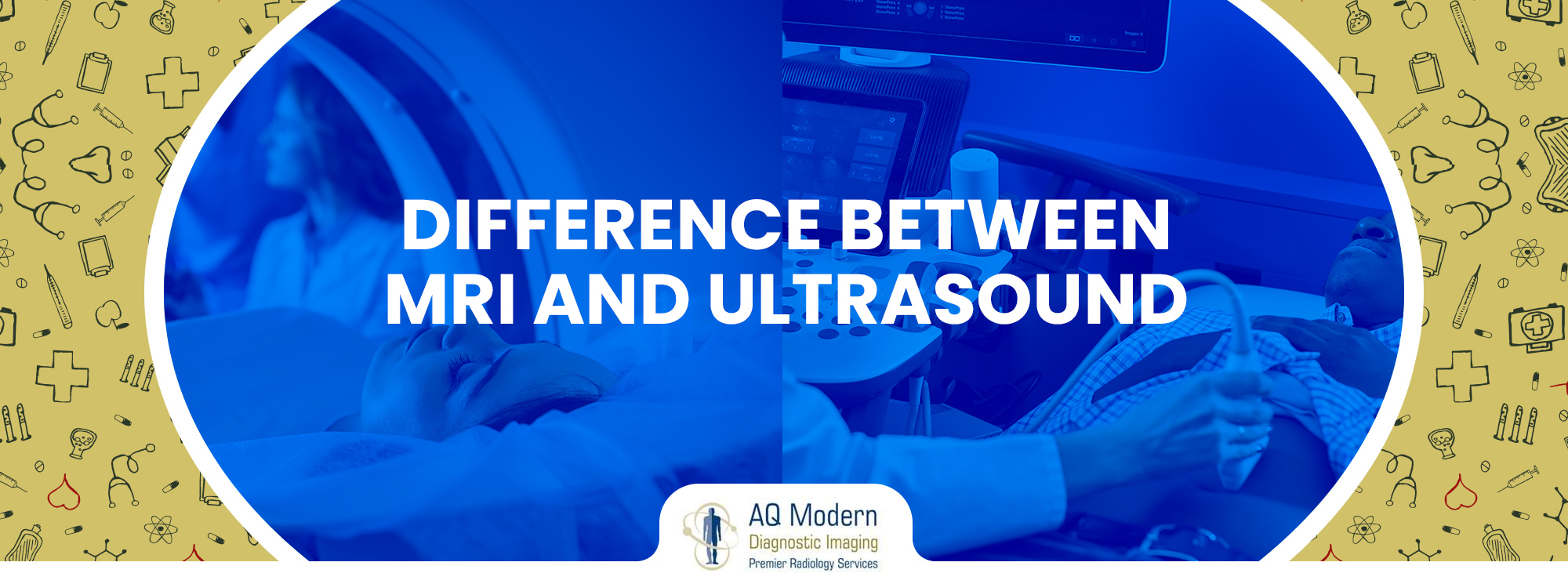Difference between MRI and Ultrasound: Explaining Two Essential Imaging Techniques
As a result, two such prominent tools are Magnetic Resonance Imaging MRI and ultrasound. While both play a crucial role in healthcare, they function in distinct ways and excel in different diagnostic scenarios.
also explore the key differences between ct scan vs pet scan vs MRI, empowering you with a clear understanding of their functionalities, applications, and limitations.
Unveiling the Technology: How MRIs and Ultrasounds Work
MRI: A Magnetic Marvel
An MRI scanner uses a strong magnetic field and radio waves to create precise cross-sectional pictures of the brain as well as soft tissues, bones, and organs. The procedure depends on the hydrogen atoms in the body lining up with the magnetic field.
Then, radio waves cause the atoms to vibrate at particular frequencies. A computer then takes these complex inputs and converts them into finely detailed, three-dimensional visuals.
Key Points:
- Powerful magnetic fields and radio waves help with the image generation.
- Creates detailed cross-sectional images.
- Capable of visualizing soft tissues, bones, organs, and the brain.
Ultrasound: Echoes for Examination
In contrast, ultrasound technology uses high-frequency sound waves to produce real-time pictures of interior structures. Moreover, sound waves emitted by a transducer—which looks like a portable wand—pass through the body. The transducer detects the echoes that are produced when these waves bounce off different densities of tissues and organs. Finally, a computer translates these echoes into visual representations on a screen.
Key Points:
- Employs high-frequency sound waves for image creation.
- Generates real-time images of internal structures.
- Well-suited for visualizing soft tissues and fluid-filled structures.
Decoding Diagnostic Applications: What Can Each Detect?
Shining a Light on What Ultrasound Can Detect
Ultrasound is a versatile tool for examining a wide range of soft tissues and fluid-filled structures within the body. So, let’s take a look at what can ultrasound detect? Its prominent applications are as follows:
Pregnancy Monitoring: Ultrasounds are the gold standard for monitoring fetal development, providing real-time glimpses of the baby’s growth and well-being.
Musculoskeletal Imaging: It facilitates the diagnosis of tears, strains, and inflammation by providing superb visualization of muscles, tendons, ligaments, and joints.
Internal Organ Assessment: Ultrasounds can effectively examine the liver, kidneys, gallbladder, and uterus, detecting abnormalities like gallstones or cysts.
Doppler Ultrasound: This specialized technique analyzes blood flow within vessels, helping identify blockages or abnormal flow patterns.
Also read:
Can Ultrasound Show Tendon Damage?
Now, you might be wondering can ultrasound show tendon damage. Ultrasound is a valuable tool for assessing tendon damage. As a matter of fact, the high-resolution images can reveal tears, inflammation, and thickening of tendons, thus allowing doctors to diagnose conditions like tendinitis and tendonitis.
MRI’s Diagnostic Prowess: What Does it Reveal?
MRIs offer unparalleled detail and versatility in examining a broad spectrum of bodily structures. Here’s a glimpse into its diagnostic capabilities:
Musculoskeletal Evaluation: Like ultrasound, MRIs assess muscles, tendons, ligaments, and joints, providing a more comprehensive view of internal structures for diagnosing complex injuries.
Brain and Spinal Cord Imaging: A brain and spinal cord image provided by an MRI is crucial for the identification of tumors, multiple sclerosis, and other neurological disorders.
Cancer Detection: MRIs can detect abnormalities in various organs, potentially indicating cancerous growths.
Soft Tissue Evaluation: In any case, MRIs excel at revealing abnormalities within soft tissues like the heart, liver, and kidneys.
Can You See Inflammation on an MRI?
Now, the question arises: can you see inflammation on an MRI? Well, MRIs can effectively detect inflammation in various tissues throughout the body. The detailed images can reveal swelling, increased fluid buildup, and changes in tissue composition, all pointing toward inflammation.
MRI vs. Ultrasound: Key Considerations for Choosing the Right Exam
When deciding between an MRI and an ultrasound, several factors come into play. These include the following:
Area of Interest: The specific body part being examined plays a crucial role. Ultrasounds provide real-time views of soft tissues and are ideal for muscles, tendons, and internal organs. MRIs, on the other hand, offer comprehensive views of various structures, including bones, soft tissues, and the brain.
Cost and Accessibility: When everything is taken into account, ultrasounds are often more accessible and less costly than MRIs.
Patient Comfort: MRIs involve lying inside a closed machine, which can be uncomfortable for some patients, especially those with claustrophobia. Ultrasounds are performed externally and are generally well-tolerated by patients.
Imaging Speed: Ultrasounds are quicker to perform, often taking just minutes. MRIs, however, can take 30 minutes to an hour or more.
Safety Considerations: For individuals who have claustrophobia or certain medical implants, MRIs are not recommended. Ultrasounds, however, are generally safe for most patients.
Is an MRI More Accurate Than an Ultrasound?
There isn’t a simple answer to this question. Both MRI and ultrasound are highly accurate imaging techniques, but their strengths lie in different areas. MRIs generally provide more detailed images, particularly of bones and deep structures. Ultrasounds excel at real-time visualization and examining soft tissues near the body’s surface.
Furthermore, in many cases, the choice between MRI and ultrasound depends on the specific clinical question. Doctors often consider a combination of factors, including the suspected condition, the patient’s medical history, and the advantages and limitations of each technique.
Bottom Line: Unveiling the Right Tool for Diagnosis
MRIs and ultrasounds are, in general, very useful tools for physicians to diagnose issues. By understanding their unique functionalities and applications, you can gain valuable insight into the best imaging technique for your specific needs.
Speak with the NJ Imaging Center if you have any queries or worries regarding a suggested imaging exam. They have cutting-edge equipment and experienced staff and doctors to carry out ultrasound in Elizabeth, NJ and guide you in the best way possible.

